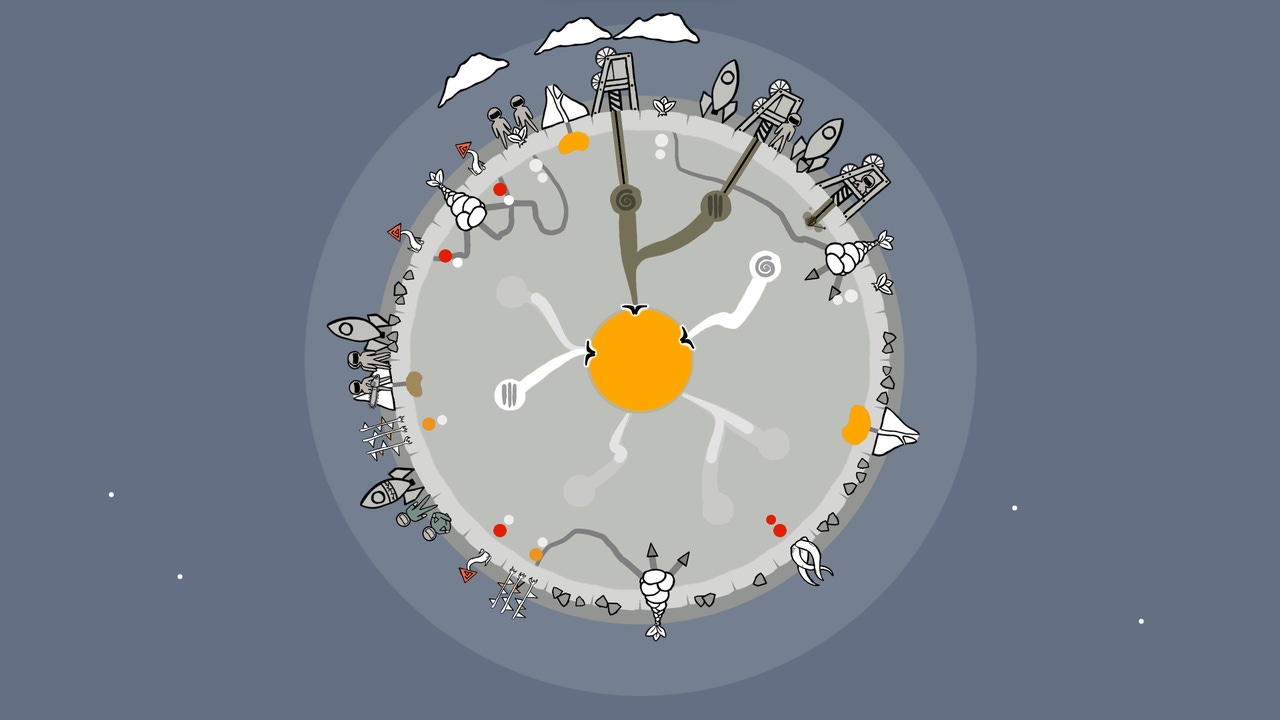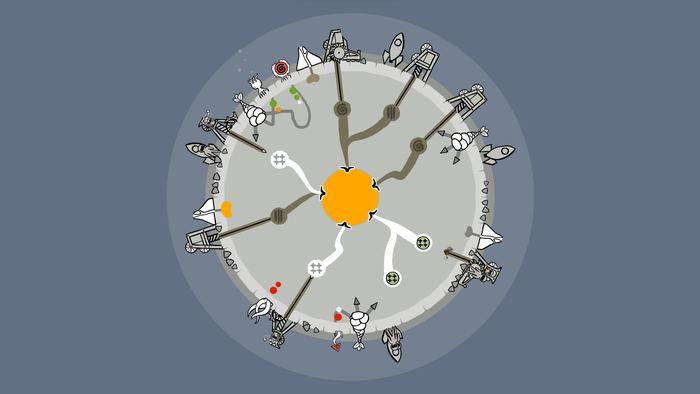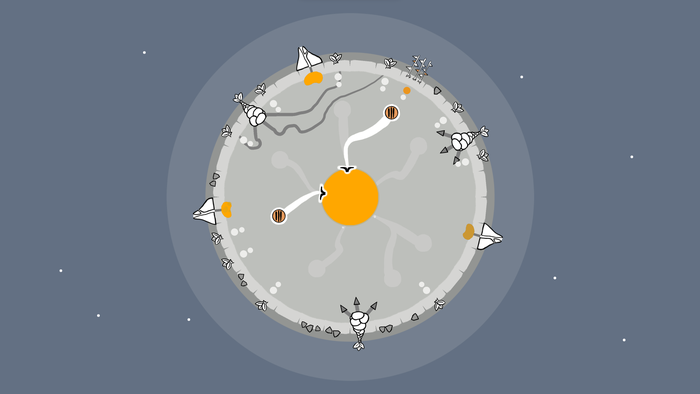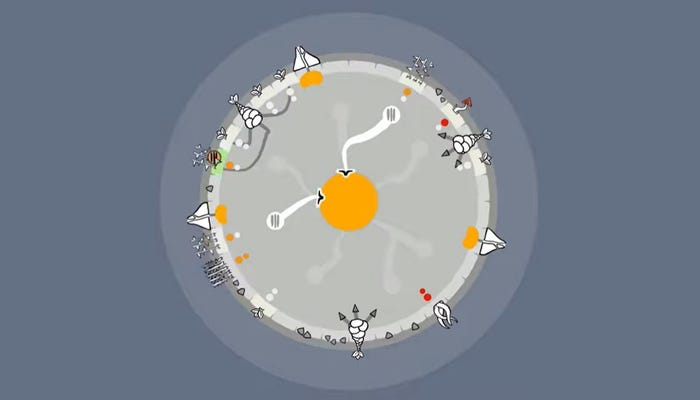Trending
Opinion: How will Project 2025 impact game developers?
The Heritage Foundation's manifesto for the possible next administration could do great harm to many, including large portions of the game development community.

The IGF (Independent Games Festival) aims to encourage innovation in game development and to recognize independent game developers advancing the medium. Every year, Game Developer sits down with the finalists for the IGF ahead of GDC to explore the themes, design decisions, and tools behind each entry. Game Developer and GDC are sibling organizations under Informa Tech.
Planetka is about a tiny sentient planet that you need to guide through growing its own ecosystem while also fending off humans who’ll mine this beautiful world until they strip it bare.
Game Developer spoke with Tereza Kotěšovcová, the game’s creator, to discuss how they wanted to look at the colonizing elements of many space exploration games from a different perspective, how they wove a sense of discovery into figuring out the game’s mechanics, and the way in which they designed means for a planet to defend itself and fight back.
Who are you, and what was your role in developing Planetka?
My name is Tereza Kotěšovcová. I am a game developer from the Czech Republic and I created Planetka as my graduation project at The Academy of Performing Arts in Prague (AMU). Acting as a one-person team, I took on the roles of designer, programmer, and artist to bring Planetka to life.
What's your background in making games?
I have always loved playing games, so when I was looking for a university, my best option was to choose programming. I studied that for six years at Charles University, and just as I finished, a new study program opened at AMU—game design. So, I started my second time at university as this was what I wanted to study from the beginning. I made a few other small games as school projects or during game jams. Planetka is my first full-fledged game.

Images via TeTerka
How did you come up with the concept for Planetka?
I started with a simple intention—I wanted to create a game I would personally enjoy playing. What I love about games is the possibilities of exploration, solving mysteries, and discovering hidden secrets. Initially, I considered space exploration games, but I found an inherent issue with them—they often turned into an endless pursuit of resources, shifting from exploration to colonization.
As I was seeking a fresh perspective, I came across a story where all flora seemed to be connected into one big sentient entity. That sparked a new idea: what if the game was viewed from the perspective of a sentient planet? It gave me an interesting new point of view which allowed me to examine the problematic aspects of exploration games while also gently pointing out real-world environmental issues.
What development tools were used to build your game?
Just Unity as a game engine, FMOD for sounds, and Procreate for drawing.
Planetka gives players control over the ecosystem of an entire planet. What thoughts went into carefully guiding them through what they can do to help their planet thrive without overwhelming the player with everything they're capable of?
Not only does the player control the whole planet, but the game is also based on exploration of game mechanics, so there is no explicit tutorial or explanation of what is available to them. The first short part of the game teaches the player the crucial mechanics only—how to create a new plant and how to mutate it into a different one. After that, most of the resources become available all at once. But the player can use them only if they are aware of them. One of the key aspects of this game is repetition. The player is destined to fail a few times, but in each playthrough they (hopefully) discover some game mechanic they missed the last time. This way, the player learns the game at their own pace. Plus, there is the nice feeling of the possibility of discovering new things each time.
How did you choose which things the players would be able to do with their planet? How did you choose the ways in which the player could care for the planet?
I wanted something contrasting with the mining machines. Something that would, at first, make it seem like it’s a hopeless situation. Fighting chainsaws and drills with plants, really? Also, it should be something that is obviously a part of the planet. That is why I turned to storms, volcanoes, and rooted plants as opposed to, for instance, animals who would have their own minds.
One of the first questions was how to make the player sympathize with the planet and not automatically with the humanoids. So, you start with the planet. I let you create things, grow some plants, and then send the humans to instantly destroy your creations with chainsaws.

Images via TeTerka
With little in the way of formal guidance, how did you teach the player about the game’s mechanics?
A very important part of the development process was figuring out how to guide the players' attention to interactable objects in a balanced manner—neither too obvious nor too hidden. For that, I relied heavily on playtesting. Coming up with ways to secretly teach the player how to play using only subtle hints and then seeing how players respond during playtesting was the part I enjoyed a lot.
For example, in early versions, players often completely missed clouds, so I made the clouds move in the atmosphere on their own. This way they'd trigger storms at random moments, drawing the players' attention to the clouds with an animation and a loud sound.
Taking care of a planet is a complicated task, but Planetka does so without a word. What drew you to cut out verbal explanations? What do you feel that added to your design? What things did this make more difficult?
It is, in part, caused by the intention to have no explicit tutorial in the game. I love it when a game doesn’t tell you exactly what to do and lets you explore a bit on your own instead. This approach makes the players pay more attention. They must observe and interpret the behaviors of the ecosystem to be able to intuitively uncover the nuances of the game mechanics, and then it rewards them with a sense of discovery. Thematically, this also makes sense because the planet doesn’t understand human language and there is no other entity that would be there to help the planet explain what to do.
As a side effect, it enhances accessibility for an international audience, eliminating the need for translations. On the other hand, it made designing visual cues to communicate with players quite challenging, but the result was well worth the effort.
What thoughts went into the visual style of the game? How did you use it to communicate with the player?
The visual style is intentionally simple. It’s partially because there is no room for much detail since everything is quite tiny when the whole game is on a single screen. That is why I also prioritized simplicity and clarity to effectively communicate player affordances. Using color as a key tool, I ensured that important elements such as invaders and core resources stood out from the rest of the planet etc.

Images via TeTerka
You also limit the amount of space to a single screen. What drew you to keep the game to this size on-screen? How did this affect the game's overall design and mechanics?
I wanted the player to see the whole planet at all times. The planet is literally the center of the game. This way, the player has full information about the game state, intensifying the feeling of pressure and urgency. They are aware of all the problems but cannot possibly hold the invaders off everywhere simultaneously.
I did initially experiment with some zooming options, but I found it only obscured the game and made it more difficult and failure was often blamed on lack of information or bad luck and players were frustrated. I left the zooming only in the Android version of the game (which should come out in March, by the way). It was a technical necessity since the planet is too small on mobile devices.
Players are preparing the planet to defend against a groups of humans who aim to strip it of its resources. What ideas went into designing the ways the planet can "defend" itself from this hostile force?
In the beginning, I brainstormed a lot of possible plant effects and types of natural catastrophes. When I was deciding which ones to keep and which ones to cut, I focused on effects that are purely defensive—the player's first motivation is to protect the planet (stunning intruders with volcanoes or blocking their path with spiky bushes). Only a bit later do they usually start to seek revenge, so there should be tools for that available as well (creating carnivorous plants and breaking buildings using storms).
That could be all, but I wanted to also add a bit of hope that violence is not the only solution. There are tools for achieving a secret ending that offers a more peaceful resolution of the conflict. However, they are extremely hard to find, because diplomacy is quite difficult when you cannot use words.
What appealed to you about taking the typical video game process of strip mining a planet to further the player goals and turning it on its head, having them protect the planet from being mined to death instead?
That was one of the ideas that started it all. I saw a trailer for a 4X game and it said something like “And you may be asking, what do you do when your planet runs out of resources? Just leave and go to the next one! There are gazillions of planets in our game!”. The game was so proud of that, but I was deeply dissatisfied with such an answer. I wanted to express my feelings and try to challenge these expectations which are common in many games.
What do you hope players take away from this experience in naturally caring for the planet through its own processes?
I hope they take away a feeling of compassion for the planet—ideally for both the one from the game and the one we are on in real life.
You May Also Like